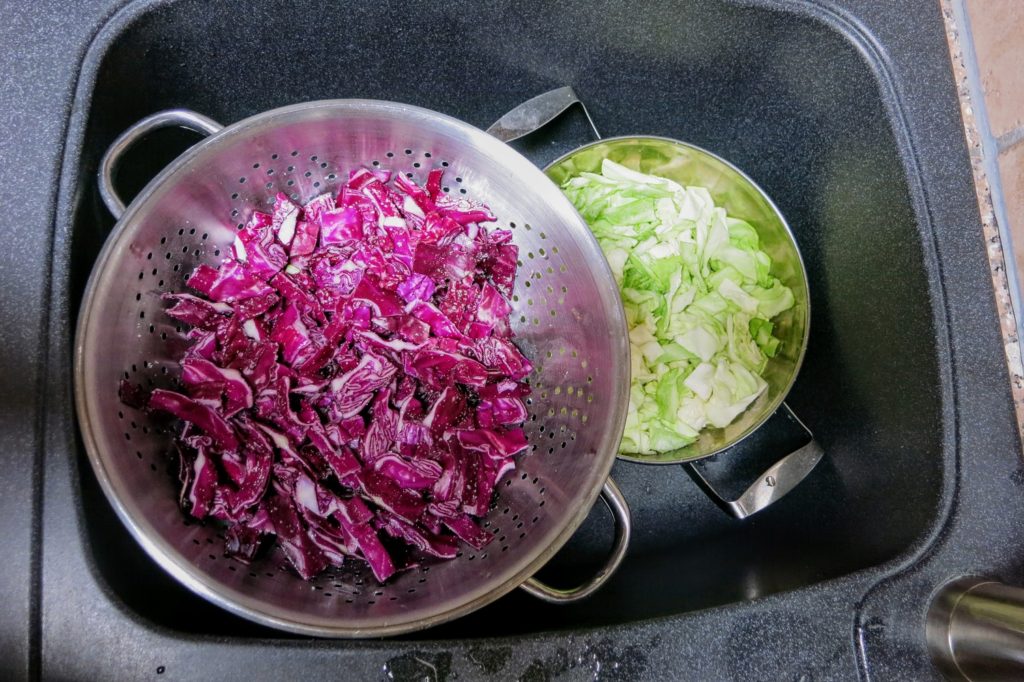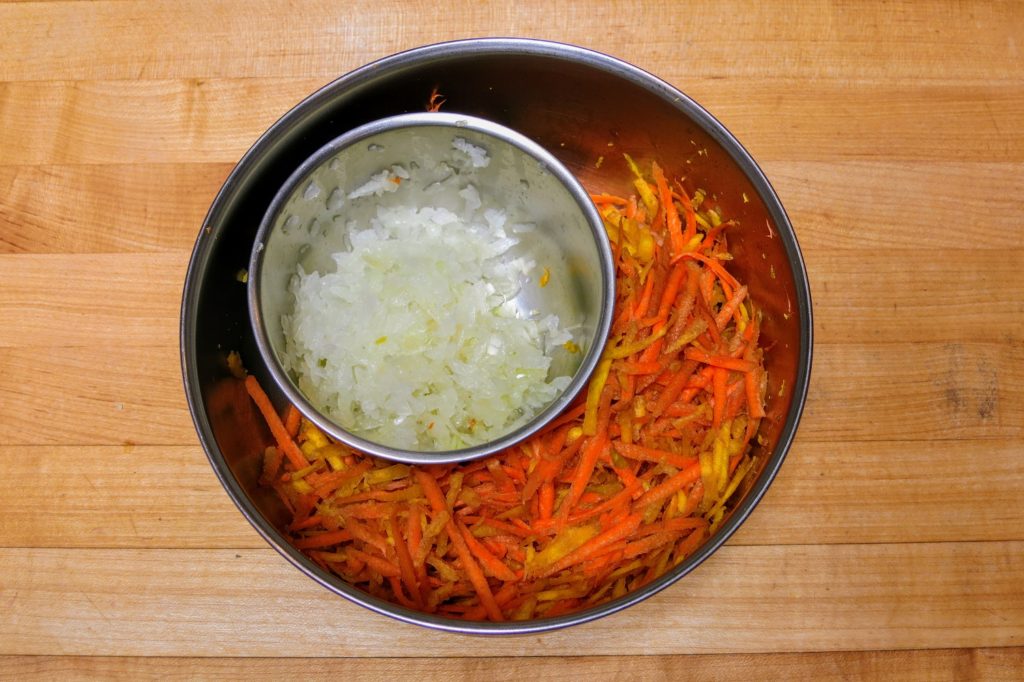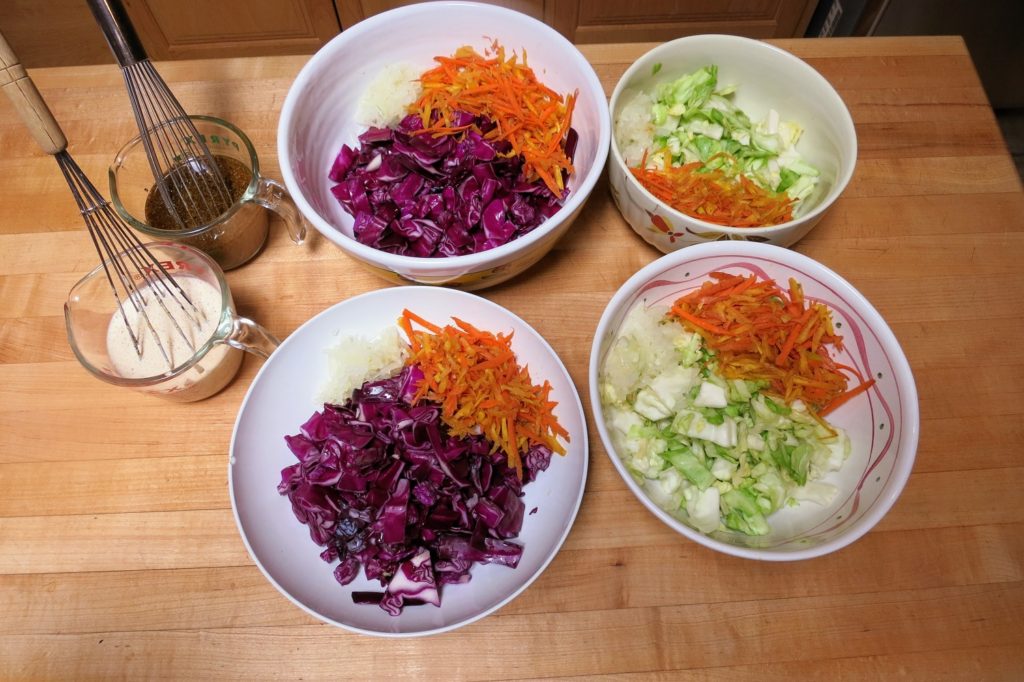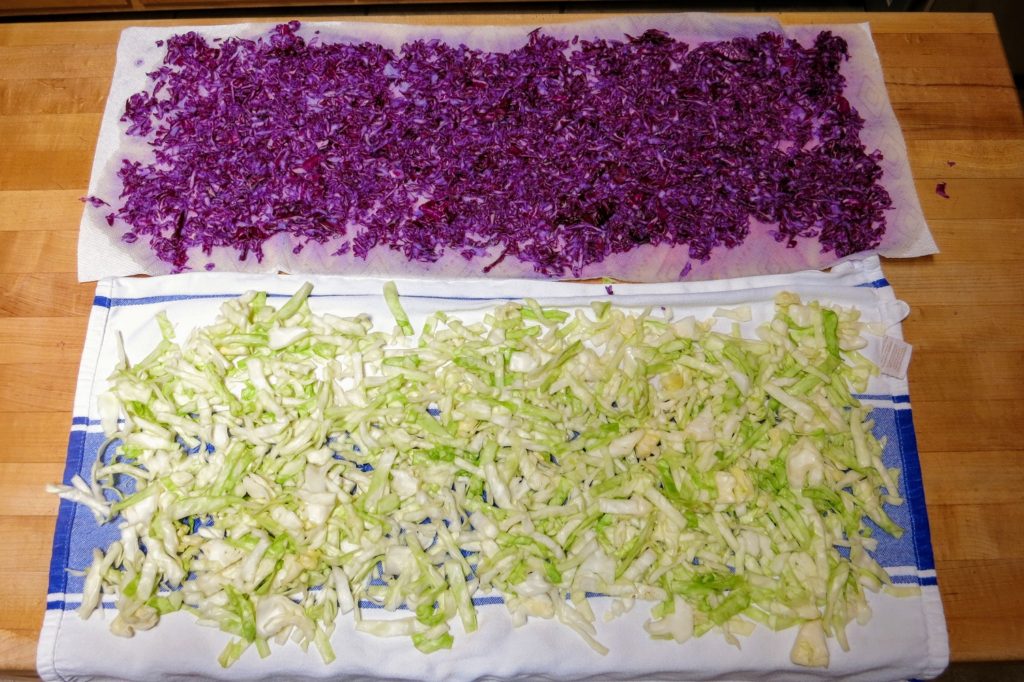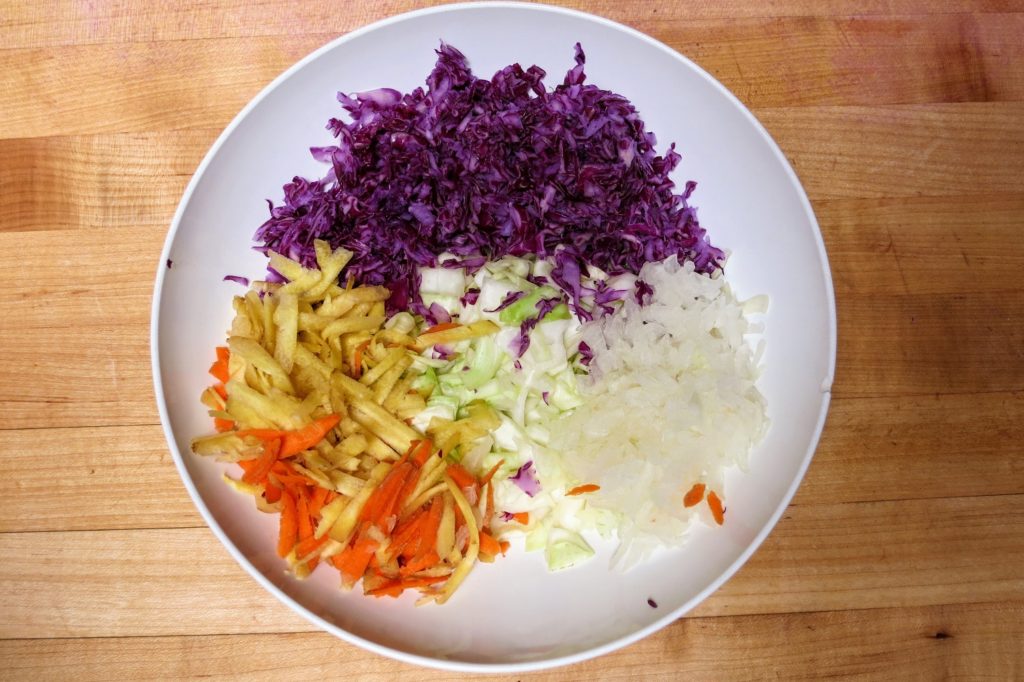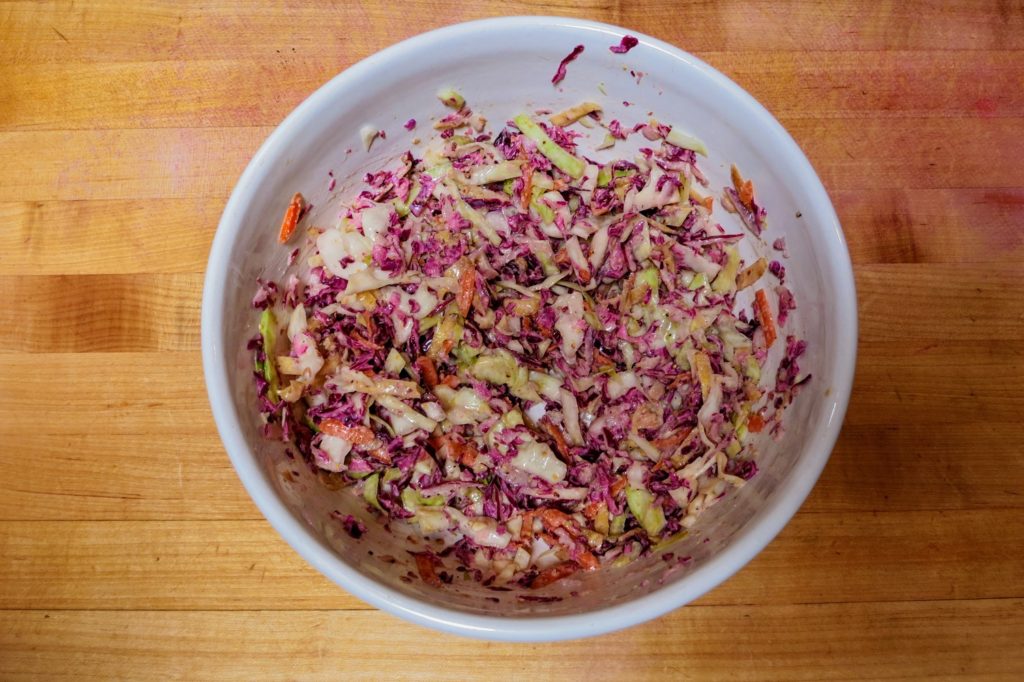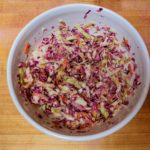I, like a lot of people, have some seriously mixed feelings about coleslaw. If made well, it can be a delicious summer side dish. Unfortunately, more often than not it’s a bland pile of soggy cabbage. The cabbage is usually too soft and the dressing tastes like nothing but sugar. It doesn’t have to be that way though. If you take a little time to make it from scratch, it can be a great addition to almost any summer meal.
Jump to RecipeWhich Kind of Cabbage is Best for Coleslaw?
Which type of cabbage you use will be based solely on your personal preferences.
Red cabbage is firmer and spicier. This allows it to hold its own better against a vibrant, vinegar-based dressing. It also means that it can fairly easily overpower a softer, mayonnaise-based dressing. It also won’t get as soft as a similarly prepared green cabbage. This means you need to slice it a lot thinner in order to get a similar texture. If you don’t have patience or a decent mandoline, this could prove annoying.
Green cabbage is more tender and sweeter. This means that its flavor can get lost in a stronger, vinegar-based dressing, but tends to be a good complement to a creamy, mayonnaise-based dressing. It definitely gets softer than red cabbage, which tends to appeal to most people. A chopped green cabbage will be about as tender as a red cabbage cut with a mandoline. If you use a mandoline on a green cabbage, you can achieve a really tender result. Texturally, tender green cabbage tends to appeal to a much wider audience than the tougher red.
Napa cabbage and Brussels sprouts are also delicious members of the brassica family. They are both incredibly tender. So much so that making them into a coleslaw can cause them to get a bit mushy. It can be done well, but you have to make quite a few adjustments. This post will focus on the standard red and green members of the brassica family.
Personally, I like using equal amounts of red and green cabbage. I use a chopped green cabbage as a base and complement it with grated red cabbage to boost flavor and texture. I think this achieves the best of both worlds and works with the widest variety of dressings.
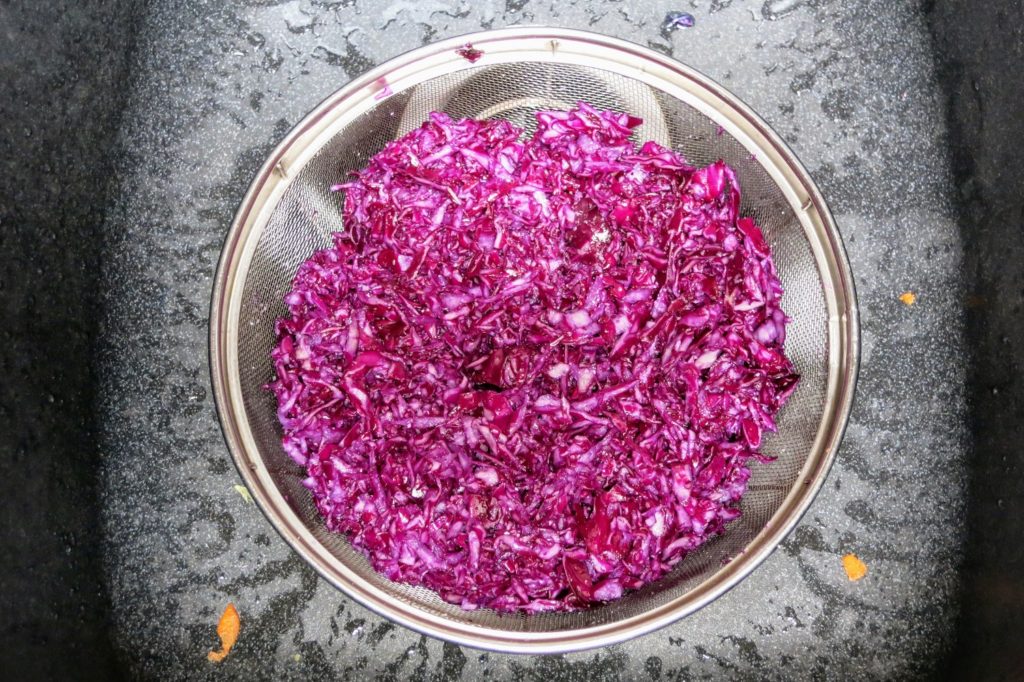
How to Prepare the Cabbage
Once you’ve chosen your cabbage, you’ll want to do more than just chop it into ribbons. You’ll also want to dry brine the cabbage in a mixture of salt and sugar to tenderize it.
First, decide how tender you want your coleslaw.
If you want a really tender coleslaw, then you’ll definitely want to use a green cabbage. You’ll want to slice it into really thin strips using either a knife or a mandoline.
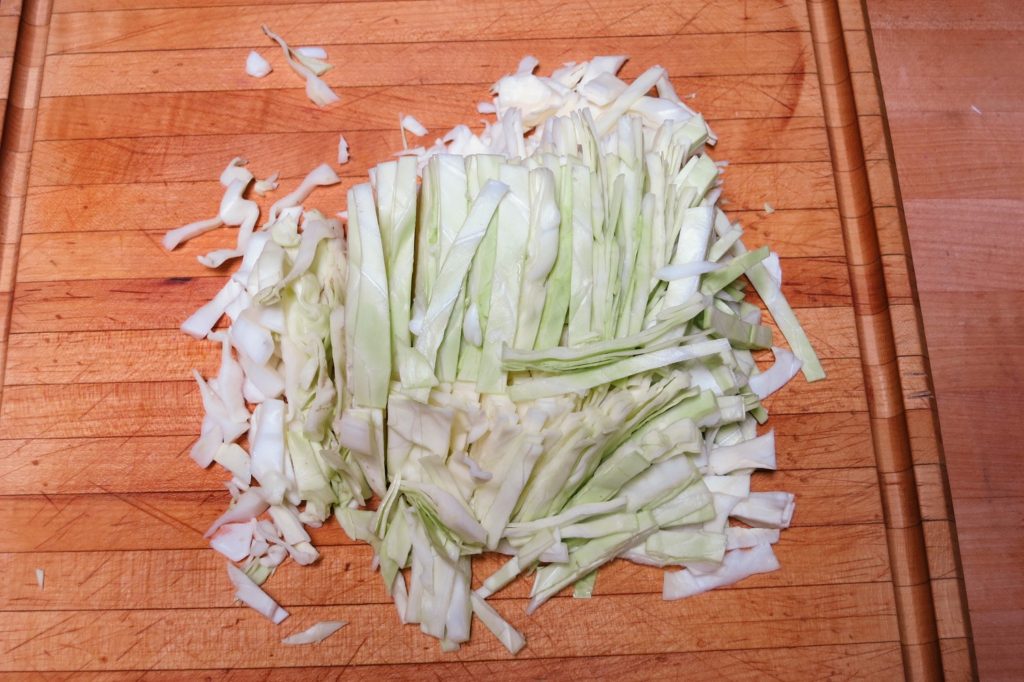
If you want a coleslaw with a little more bite, then you can use either a green or a red cabbage. You can either slice a red cabbage very thinly, or use a more roughly chopped green cabbage.
Lastly, if you want a really tough coleslaw, you can either use a chopped, unbrined green cabbage, or a roughly chopped red cabbage. Both will provide a coleslaw that basically feels like eating raw cabbage. It doesn’t necessarily make bad food, but I personally think it makes a bad coleslaw.
After you’ve sliced your cabbage, you’ll want to brine it. To do this, you’ll place the cabbage into a large bowl and mix it with equal portions sugar and salt. Both are extremely hygroscopic and great at yanking liquid out of cell walls. Using a combination of sugar and water allows you to get the power of a heavy brine without making the final product taste overly salty or sweet.
Brining the cabbage will improve both the texture and the flavor of the final product. For one, it tenderizes the cabbage by breaking down a bunch of cell walls. In doing this, it removes a lot of water, which concentrates the flavor of the cabbage, improving flavor.
If you don’t brine your cabbage, the final product won’t really be texturally like coleslaw, no matter how thinly you slice the cabbage. Instead it will be more like a blander, cabbage salad.
Since it only takes an extra 10 minutes and greatly improves the final product, it’s definitely worthwhile.
Other Vegetables
You don’t really need anything else but cabbage and dressing to make coleslaw, but other vegetables help to round it out.
Carrots
I think carrots are basically a necessity. You can use whatever color or type you want, the only thing that really matters is how you grate them. Make sure to run the carrots diagonally along the large holes of a grater. If you hold it perpendicular to the grater, the strands are too short. Longer strands hold their own better in a salad.
Onions
The other standard is onion. A lot of people use red onion, but I think it provides too much bite. I find that it overpowers the softer flavors of the cabbage and the carrots. If you like a stronger onion flavor, then red’s awesome, but I prefer sweet onion. It provides a nice oniony bite without being overpowering.
I also grate my onion. Instead of slicing it, I use the large holes of a grater. It makes for smaller pieces which allows for the flavors to permeate better through the salad while avoiding any large chunks of onion.
Herbs
Lastly is herbs. Some people add a bunch of parsley or cilantro to their coleslaw. I don’t really bother. If you want to, go for it. You’ll want a good amount of flat-leaf parsley or else it will get lost in the flavor of the dressing.
What Kind of Dressing?
Now that vegetables are out of the way, we have to think about dressing. There are two primary categories when considering coleslaw dressings: mayonnaise-based and vinegar-based.
Mayonnaise-Based
This is probably what comes to mind for most people when they hear “coleslaw.” Much like ranch dressing, it tends to have a very widespread appeal. It’s creamy, savory, and pretty well-balanced. Most people I know tend to prefer the mayonnaise-based dressing. It’s creaminess can be a positive or a negative when pairing it with main courses. Serving a mayonnaise-based coleslaw with a really flavorful rack of ribs or a spicy brisket is a gamble. On one hand, it could balance out the flavors and make a better meal. On the other hand, it could easily be overpowered by the strength of the meat.
Vinegar-Based
The vinegar-based dressing is a little harder to balance, but done correctly, it’s delicious. Not only is it a nice mix of sweet and sour, but it also creates a really pretty coleslaw. The color of the vegetables really comes through in this semi-clear dressing so it looks really nice on the plate. Unlike a mayonnaise dressing, a vinegar dressing is going to better hold its own against strong flavors. A bold, vinegar-based dressing has little chance of being overpowered, even by some of the stronger flavors in barbecue. That said, it has little chance of rounding out a meal as well as a quality mayo slaw.
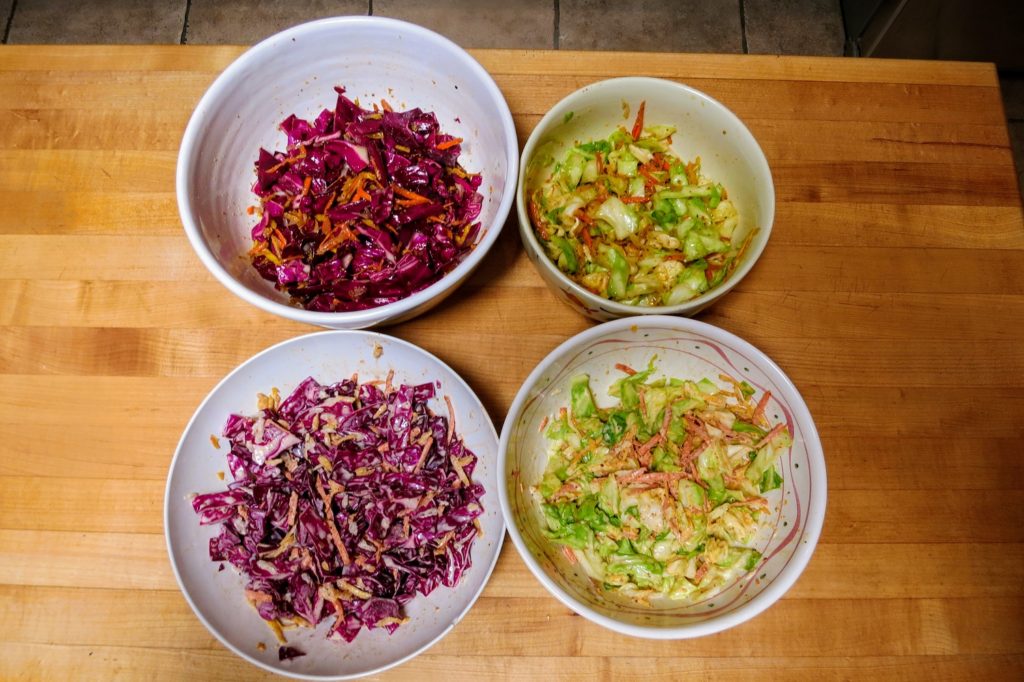
In the end, it really comes down to preference. You can argue pairings and flavors all you want, but if you prefer one over the other, that’s all that matters. For example, my mom tends to like mayo slaws better, regardless of the situation. After taste testing all of these in conjunction with the ribs, her answer always came back to green cabbage with mayo dressing. If you have a preference, just go with it.
One last thing to think about: the mayonnaise slaw started to lose flavor after about 3 days. It was still good, it just wasn’t as good as it was after 1 day. If you’re busy and need to make coleslaw on the weekend for a party on Thursday, then I recommend a vinegar dressing.
Spices and Seasonings
After you decide your type of dressing, you’ll want to add some flavor.
First of all, don’t add any salt. The cabbage is almost certainly salty enough from brining. If you salt the dressing, you run the risk of over salting it by a lot.
You’ll also want some sugar. I tend to use far less than most people because I really prefer savory to sweet. If you like your coleslaw sweeter, then add more sugar.
As far as flavorings, I start with mustard and garlic because I think they’re basically essential to every salad dressing. I use garlic powder because I think it permeates better than fresh, minced garlic. I also use some celery seed. It adds a great vegetal quality and a nice texture. Then I throw in some cayenne because for me, spicy food is good food.
Last but not least, pepper. Black, mixed, or white, add a bunch of pepper. Pepper and cabbage go so well together they should get married. So unless you dislike pepper, grind a bunch in there.
If you want a different flavor, change it around. Hate something on the list? Leave it out. If you’re stumped and want some suggestions, feel free to ask. I’d be happy to help.
How to Make the Coleslaw
Once you’ve chosen your vegetables and decided on a dressing, coleslaw’s a pretty simple process.
For my favorite slaw, I like to use a mix of green and red cabbage. The green provides a good base for slaw and the red contributes a nice, peppery flavor. I find that thinly slicing the green gives a good primary texture and grating the red allows you to get the flavor without negatively affecting the texture of the overall slaw.
After you cut the cabbage, coat it in salt and sugar and let it brine for 5 minutes. I recommend doing it in a sieve in the sink. After 5 minutes, rinse it thoroughly to get rid of the extra salt and sugar. Once rinsed, give it a good shake and then lay it out on a kitchen towel or a layer of paper towels. Lay another kitchen towel or more paper towels on top and then press to dry. You can squeeze it dry, but it will make the final coleslaw a lot mushier.
NOTE: If using red cabbage, it will stain your kitchen towels. I’m not the type to care, but if you don’t want bluish-purple towels, then definitely use paper towels.
While the cabbage is brining, grate the onion and the carrots. Then after rinsing the cabbage, mix together all the vegetables.
Finally, make the dressing. No matter which type of dressing you choose, it’s the same procedure. Just mix everything in a bowl and whisk until it comes together in a smooth mixture.
Pour the dressing over the the vegetables and stir to combine. I like to get in there with my hands and mix it, but you can use a large spoon if you don’t like getting dirty.
You can serve immediately alongside other summer favorites. Though for best texture and flavor, let it sit in the fridge overnight and serve it the next day.
Hopefully, this helps to better create a coleslaw you’ll really like.
Coleslaw – Two Types
Ingredients
Vegetables
- 1/2 head green cabbage core removed, thinly sliced
- 1/2 head red cabbage core removed, grated
- 2 large carrots grated
- 1 large sweet onion grated
- 1/4 cup kosher salt
- 1/4 cup granulated sugar
Option 1: Mayonnaise-Based Dressing
- 1 cup mayonnaise see note*
- 1/2 cup apple cider vinegar
- 1/4 cup whole grain mustard or Dijon
- 2 Tablespoons sugar
- 1 teaspoon garlic powder or two cloves minced garlic
- 1 teaspoon black pepper about 50 coarse grinds
- 1 teaspoon celery seed
- 1/2 teaspoon cayenne pepper see note**
Option 2: Vinegar-Based Dressing
- 1 cup apple cider vinegar
- 1 cup sugar
- 1/4 cup extra virgin olive oil
- 1/4 cup whole grain mustard or Dijon
- 1 teaspoon garlic powder or two cloves minced garlic
- 1 teaspoon black pepper about 50 coarse grinds
- 1/2 teaspoon celery seed
- 1/2 teaspoon cayenne pepper see note**
Instructions
Vegetables
- Thinly slice the green cabbage and grate the red. Put it in a colander/sieve in the sink and coat with 1/4 cup kosher salt and 1/4 cup sugar. Stir to mix and then brine for 15 minutes. Then rinse thoroughly, give it a shake, then let it dry between paper towels.
- In a large bowl, mix the brined cabbage, the grated carrots, and the grated onion.
Dressing
- Add all the ingredients for one of the dressings to a large bowl. Whisk to combine and then pour over the vegetables. Stir with your hand or a large spoon until well coated.
- Serve immediately, or let it sit in the fridge overnight for even better flavor.

